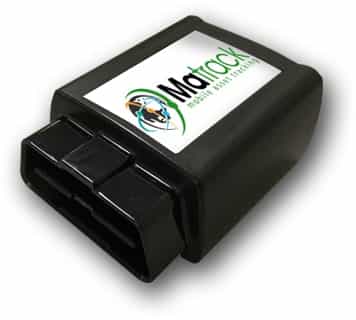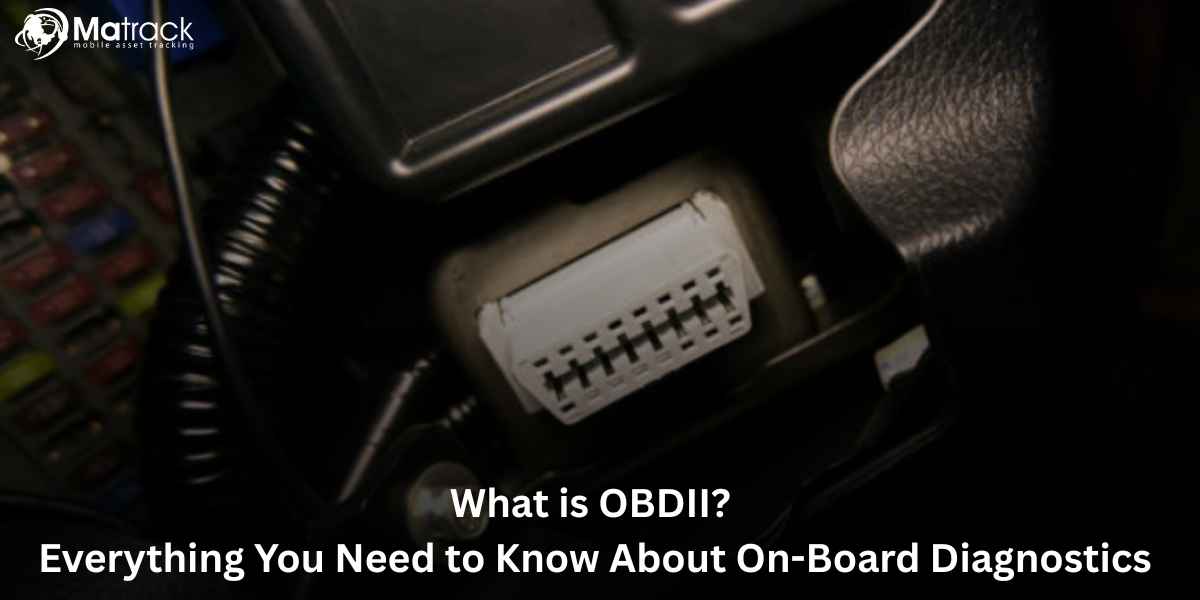Key Takeaways:
- OBD is a built-in system that checks engine, fuel, and emission performance in real time.
- The OBDII port is a standard connector that gives direct access to vehicle diagnostics.
- OBDII data and telematics together help detect issues early and improve fleet management.
- Matrack OBD Plug-In Fleet Tracker makes it easy to monitor vehicles and driver behavior instantly.
What is an OBD (On-Board Diagnostics)?
OBD (On-Board Diagnostics) is a built-in system used in vehicles to track the performance of key parts like the engine, fuel system, and emission controls. The OBD system constantly checks these components to make sure they are working properly.
When the OBD system finds a problem, it turns on the Check Engine Light and saves a Diagnostic Trouble Code (DTC) in the car’s Engine Control Unit (ECU). This code helps mechanics and car owners identify the exact issue without opening up the vehicle.
Why is the OBDII Port Important?
The OBDII port is important because it:
- Helps find car problems quickly by showing clear error codes for each system
- Saves time on repairs by giving fast access to the car’s engine, fuel, and emissions data
- Checks how well your emission system is working to meet clean air rules
- Works with GPS fleet tracking and scan tools to monitor things like fuel use, speed, and engine health
These features make your vehicle safer, easier to maintain, and legal to drive under emission laws.
How to Locate the OBDII Port?
The OBDII port is usually found under the dashboard, close to the steering wheel. Most cars have it within 2 feet of the driver’s seat, often above the pedals or just below the steering column.
You can look in these common spots:
- Right under the steering wheel, near the brake pedal
- Behind a small plastic cover under the dashboard
- Next to the fuse box on the driver’s side
- Inside the center console in some high-end cars
The port is a small, 16-pin rectangular connector. If it’s hard to find, just check your car manual or search online with your car’s make and model.
OBDII Port Pin Layout Explained
The 16 pins of the OBDII port follow a standard layout defined by the SAE J1962 protocol. Here are the 8 most critical pins:
- Pin 4 & Pin 5: Ground (chassis and signal)
- Pin 6 & Pin 14: CAN High and Low (for Controller Area Network)
- Pin 7: K-Line (ISO 9141-2 protocol)
- Pin 16: Battery voltage (12V power)
- Pin 2 & Pin 10: J1850 Bus (PWM or VPW protocols)
This layout supports multiple communication protocols depending on the vehicle’s make and model.
Types of OBDII Protocols
There are five OBDII protocols that determine how diagnostic data is transmitted:
- SAE J1850 PWM: Common in Ford vehicles
- SAE J1850 VPW: Common in GM vehicles
- ISO 9141-2: Common in European and Asian vehicles
- ISO 14230-4 (KWP2000): Advanced version of ISO 9141
- ISO 15765-4 (CAN): Standard for cars since 2008
Each protocol uses a specific pin configuration, which is auto-detected by modern OBDII readers.
What Can Be Read via the OBDII Port?
An OBDII scanner retrieves both static and dynamic information. This includes:
- Stored trouble codes (e.g., P0301 for cylinder misfire)
- Live sensor data (e.g., RPM, engine temperature)
- Readiness monitors (e.g., catalytic converter status)
- Freeze frame data (snapshot at the time of error)
- Vehicle Identification Number (VIN)
These details are used for maintenance, diagnostics, and performance enhancement.
How to Use an OBDII Scanner
To use an OBDII scanner:
- Locate the port under the dashboard
- Plug in the scanner
- Turn on the ignition without starting the engine
- Follow scanner prompts to read or erase codes
- Interpret the results using a code reference guide
Modern scanners display code meanings and suggest repair steps.
Common OBDII Trouble Codes
Here are 6 common diagnostic codes and what they indicate:
- P0171: System too lean (Bank 1)
- P0300: Random/multiple cylinder misfire
- P0420: Catalyst efficiency below threshold
- P0455: Large EVAP system leak
- P0113: Intake air temperature sensor circuit high
- P0446: EVAP vent control circuit malfunction
Each code starts with a letter: P (Powertrain), B (Body), C (Chassis), or U (Network).
OBDII in EVs and Modern Vehicles
Modern electric vehicles (EVs) also use OBDII ports, but with some differences:
- They monitor battery management systems (BMS)
- Report charging cycle data and efficiency
- Support advanced diagnostics for electric drive modules
As EV adoption rises, OBDII continues to evolve to support newer technologies.
Benefits of OBDII Port Access
Having access to the OBDII port makes owning and taking care of a car much easier. It gives real value by helping you understand your car’s condition anytime.
Main benefits include:
- Finding problems early, so you can fix issues before they cause breakdowns
- Doing your own checks at home without needing a trip to the mechanic
- Making smarter repair choices by reading and understanding Diagnostic Trouble Codes (DTCs)
- Tracking and managing multiple vehicles, which is helpful for fleet and logistics companies
OBD vs. OBDII: Key Differences
| Feature | OBDI | OBDII |
| Standardization | Manufacturer-specific | Industry-standard |
| Year Introduced | Early 1980s | 1996 |
| Connector Type | Varies | 16-pin universal |
| Code Format | Non-standard codes | Generic and manufacturer DTCs |
| Diagnostic Access | Limited | Extensive |
OBDII replaced OBDI for its broader compatibility, standardized connectors, and real-time monitoring.
OBD and Telematics
OBD (On-Board Diagnostics) and telematics work together to provide real-time insights into a vehicle’s mechanical condition and usage patterns. Telematics systems use data from the OBDII port to monitor how the vehicle is driven and how well it’s performing internally.
Key functions supported by OBD-powered telematics:
- Live engine diagnostics: reads fault codes and performance data while the vehicle is in use
- Fuel usage tracking: monitors real-time fuel consumption to spot inefficiencies
- Idle time analysis: identifies unnecessary engine run time to reduce wear and fuel waste
- Maintenance alerts: sends automated reminders based on engine hours or usage patterns
- Driver behavior reports: tracks patterns like harsh braking or rapid acceleration for performance reviews
Combining OBD with telematics improves maintenance accuracy, reduces downtime, and helps operators and owners make smarter decisions based on real usage data.
Take Control of Your Fleet in Seconds with Matrack OBD Plug-In Tracker

Matrack OBD Plug-In Fleet Tracker connects directly to a vehicle’s OBDII port and starts working right away, no tools or wiring needed. It’s a quick solution for tracking both vehicle health and driver activity in real time.
This tracker helps monitor engine performance, fuel use, and idle time, giving clear data to reduce downtime and avoid costly repairs. It also captures key behaviors like harsh braking and speeding to improve driver safety.
You can access everything through Matrack’s simple dashboard and mobile app, making it easy to manage your fleet from anywhere. The plug-in design makes it perfect for fleets that need fast setup and reliable tracking.



